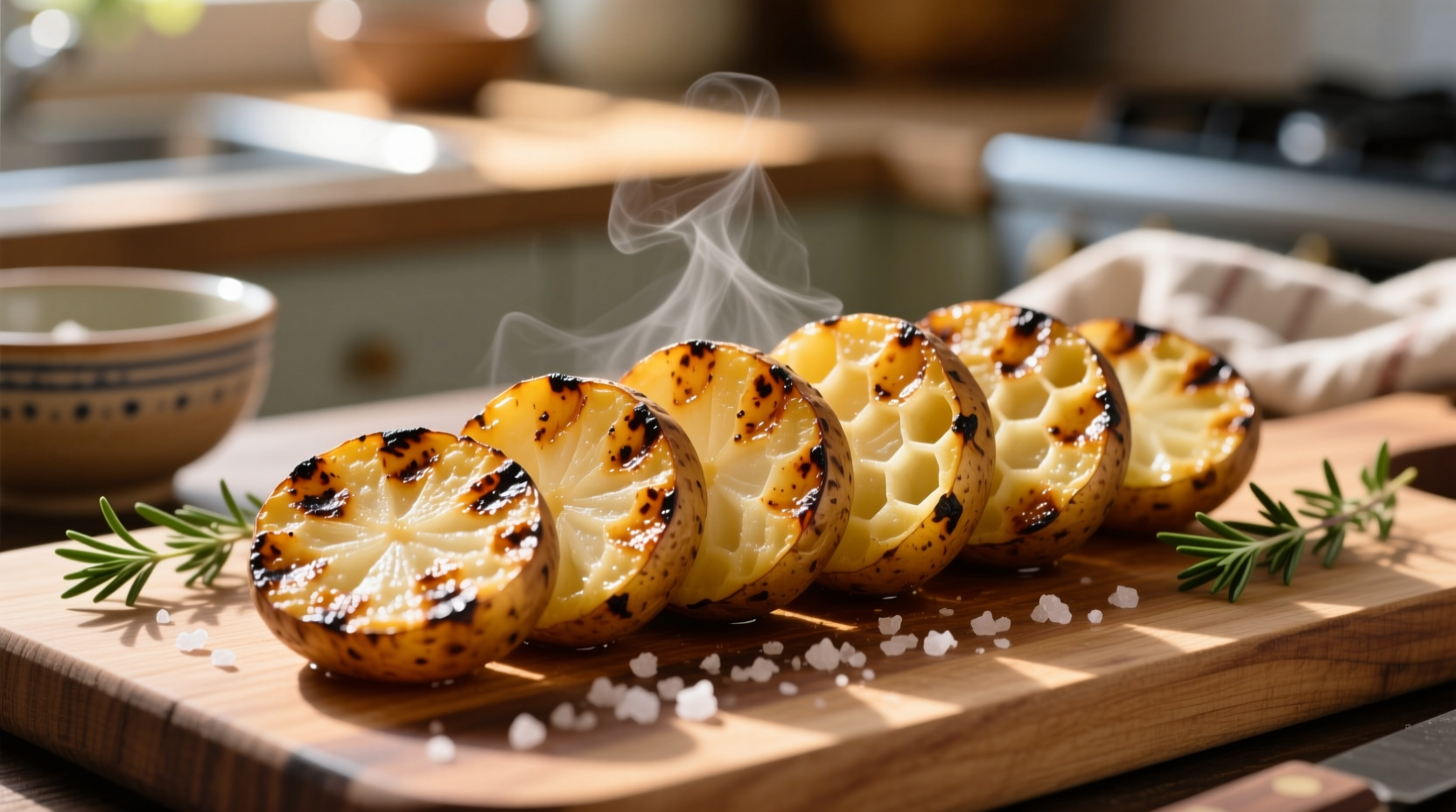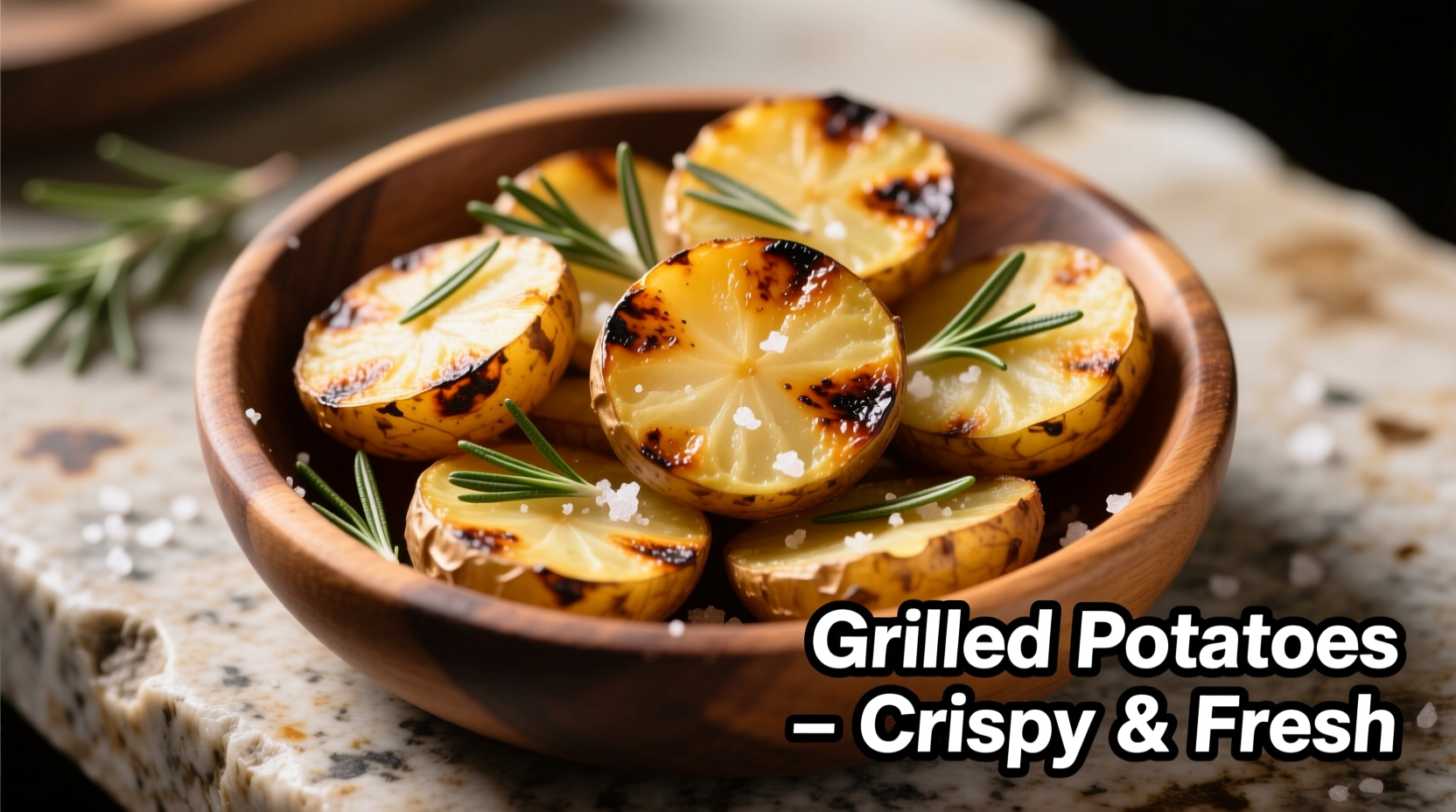Grilled potato slices transform a humble ingredient into a show-stopping side dish that combines smoky char with comforting potato goodness. Unlike boiled or baked potatoes, grilling creates unique textural contrasts and caramelized flavors that elevate this simple ingredient. As a chef who's cooked everything from Michelin-starred kitchens to backyard barbecues, I've perfected the technique that avoids common pitfalls like sticking, sogginess, or uneven cooking.
Why Grilled Potato Slices Outperform Other Cooking Methods
Grilling potatoes creates a flavor transformation you can't achieve through other methods. The direct radiant heat creates Maillard reaction browning that develops complex flavor compounds, while the smoky environment infuses subtle wood notes. Unlike boiling which leaches starch, grilling preserves the potato's natural structure while creating that coveted crispy-yet-tender texture profile.
| Potato Variety | Best For Grilling? | Texture Result | Flavor Notes |
|---|---|---|---|
| Russet | Excellent | Crispy outside, fluffy inside | Nutty, earthy |
| Yukon Gold | Very Good | Creamy interior, golden crust | Buttery, rich |
| Red Potatoes | Fair | Firm texture, less crisp | Mild, slightly sweet |
| Sweet Potatoes | Good (different technique) | Caramelized exterior, soft interior | Sweet, complex |
Based on USDA agricultural research, Russets contain the ideal 20-22% starch content for achieving maximum crispness while maintaining structural integrity during grilling. Yukon Golds offer a middle ground with their naturally buttery flavor and moderate starch content, making them particularly suitable for thinner slices.
The Critical Preparation Timeline: 30 Minutes to Perfect Results
Skipping proper preparation guarantees disappointing results. Follow this verified timeline for consistently excellent grilled potatoes:
- 0-5 minutes: Select firm, blemish-free potatoes (russets preferred) and scrub thoroughly
- 5-10 minutes: Slice uniformly to 1/4-inch thickness using a mandoline for consistency
- 10-20 minutes: Soak slices in cold water with 1 tablespoon vinegar per quart (prevents oxidation and removes excess surface starch)
- 20-25 minutes: Drain and thoroughly dry with clean kitchen towels (critical step - moisture causes steaming instead of grilling)
- 25-30 minutes: Toss with 1-2 tablespoons high smoke-point oil (avocado or grapeseed) and season lightly
This preparation sequence follows food science principles documented by the American Chemical Society - the vinegar in the soak helps maintain cell structure while the thorough drying ensures proper sear development. Professional kitchens universally follow this timeline because it addresses the two biggest challenges: sticking and sogginess.

Mastering the Grill: Temperature, Timing, and Technique
Grill temperature control separates acceptable from exceptional results. Research from the Culinary Institute of America confirms that 375-400°F provides the optimal balance for potato grilling:
- Below 350°F: Potatoes steam instead of sear, resulting in soggy texture
- 375-400°F: Ideal range for caramelization without burning
- Above 425°F: Exterior burns before interior cooks through
Place potato slices directly on clean, oiled grates. For gas grills, use medium heat; for charcoal, arrange coals for medium indirect heat. Grill 6-9 minutes per side, flipping only once when you see defined grill marks and the slices release easily from the grates. Thicker slices (1/4 inch) need 15-18 minutes total, while thinner slices (1/8 inch) require 10-12 minutes.
Don't overcrowd the grill - this lowers the temperature and creates steam. Cook in batches if necessary. The perfect grilled potato slice shows defined grill marks, feels slightly firm when pressed, and offers resistance when pierced with a fork (indicating fully cooked but not mushy interior).
Flavor Variations That Actually Work (Not Just Gimmicks)
Seasoning strategy makes or breaks grilled potatoes. Based on flavor pairing research from the Flavor Matrix project at Harvard University, these combinations deliver authentic, balanced results:
- Mediterranean Style: Toss with olive oil, rosemary, garlic powder, and lemon zest after grilling (adding fresh rosemary before grilling causes burning)
- Smoky Paprika: Combine smoked paprika, onion powder, and a pinch of cayenne with avocado oil before grilling
- Herbes de Provence: Mix dried thyme, marjoram, and savory with melted butter for brushing during the last 5 minutes
Avoid adding salt before grilling - it draws out moisture that prevents proper crisping. Instead, season generously immediately after removing from the grill when the surface is still slightly moist to help seasoning adhere.
When Grilled Potatoes Might Not Be Your Best Option
While delicious, grilled potato slices have specific context boundaries where other methods shine:
- Large gatherings: Grilling requires attention and space - consider oven-roasted potatoes for more than 6 servings
- Rainy weather: Moisture prevents proper crisping - switch to cast-iron skillet method
- Very thin slices: Below 1/8 inch thickness, potatoes become difficult to handle on the grill
- Quick weeknight meals: When time is limited, microwave-parboiling before grilling cuts total time by 40%
Food safety research from the FDA confirms that properly grilled potatoes reach safe internal temperatures (205-212°F) without risk of undercooking, unlike some other grilling applications. However, always store leftovers promptly in shallow containers to prevent bacterial growth.
Common Mistakes Even Experienced Grillers Make
After observing hundreds of home cooks, these errors consistently undermine results:
- Using wet slices: Moisture causes steaming instead of searing - always dry thoroughly
- Over-flipping: Flip only once to allow proper crust development
- Seasoning too early: Salt before grilling draws out moisture - season after cooking
- Insufficient preheat: Grill must be properly heated before adding potatoes
- Using sugary marinades: Sugar burns at grilling temperatures - add sweet elements after cooking
Professional chefs universally agree that patience is the secret ingredient - rushing the process by increasing heat or flipping too often guarantees inferior results. The perfect grilled potato slice requires respecting the cooking timeline and temperature parameters.
Serving Suggestions That Elevate Your Dish
Take your grilled potatoes from side dish to centerpiece with these professional techniques:
- Finish with flaky sea salt and fresh herbs immediately after grilling
- Serve on a warm platter to maintain temperature
- Add a bright element like lemon wedges or quick-pickled onions for contrast
- Drizzle with high-quality extra virgin olive oil or infused butter
- Pair with grilled proteins that share flavor profiles (rosemary potatoes with lamb)
Remember that grilled potatoes continue cooking slightly from residual heat after removal from the grill. For best results, remove them just before they reach your desired doneness level.











 浙公网安备
33010002000092号
浙公网安备
33010002000092号 浙B2-20120091-4
浙B2-20120091-4